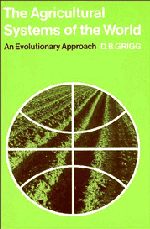Book contents
- Frontmatter
- Contents
- Acknowledgements
- 1 Introduction
- PART ONE
- PART TWO
- 5 Shifting agriculture
- 6 Wet-rice cultivation in Asia
- 7 Pastoral nomadism
- 8 Mediterranean agriculture
- 9 Mixed farming in western Europe and North America
- 10 Dairying
- 11 Plantations
- 12 Ranching
- 13 Large-scale grain production
- 14 Conclusions
- Appendix: Regions of plant domestication
- Notes
- Bibliography
- Index
- Frontmatter
- Contents
- Acknowledgements
- 1 Introduction
- PART ONE
- PART TWO
- 5 Shifting agriculture
- 6 Wet-rice cultivation in Asia
- 7 Pastoral nomadism
- 8 Mediterranean agriculture
- 9 Mixed farming in western Europe and North America
- 10 Dairying
- 11 Plantations
- 12 Ranching
- 13 Large-scale grain production
- 14 Conclusions
- Appendix: Regions of plant domestication
- Notes
- Bibliography
- Index
Summary
The most important factors in explaining the present distribution of the major types of agriculture are, first, the slowness of technical change in agriculture until the nineteenth century, and, second, the very limited areas in which the new techniques of the nineteenth and twentieth centuries have been adopted. Thus the simplest and perhaps the most useful classification of modern agriculture is into those countries which have experienced economic development in the last century and those which have not.
Until about A.D. 1600 there was probably very little difference in agricultural productivity between Europe, India and China. Thereafter the reduction of fallow, the elimination of medieval institutions and the introduction of roots and grasses gave significant increases in crop yields. But the major break came in the nineteenth century with the introduction of labour-saving machinery, the use of steam and later electricity on the farms, and the petrol-driven tractor, the use of inorganic fertilisers and the application of scientific knowledge to plant and animal breeding. Although most of these advances came in the later nineteenth century they have not been widely adopted until the last forty years. This period has been a real agricultural revolution in western farming.
This was a direct result of industrialisation; although the earlier agricultural revolution of the eighteenth century had made possible the industrial revolution in Europe, it was industrialisation that caused the major changes in agriculture which began in the later nineteenth century. Higher incomes led to a shift in demand from grain to livestock products, vegetables and specialised tropical products, whilst factory industries generated a demand for cotton, wool, jute, rubber and vegetable oils.
- Type
- Chapter
- Information
- The Agricultural Systems of the WorldAn Evolutionary Approach, pp. 284 - 286Publisher: Cambridge University PressPrint publication year: 1974



